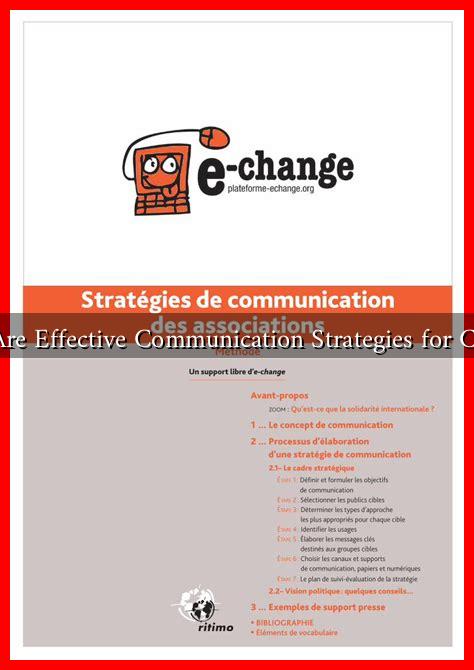-
Table of Contents
- What Are Effective Communication Strategies for Change?
- The Importance of Communication in Change Management
- Key Communication Strategies for Effective Change Management
- 1. Develop a Clear Message
- 2. Use Multiple Channels
- 3. Foster Two-Way Communication
- 4. Communicate Frequently and Consistently
- 5. Highlight Success Stories
- Case Study: The Role of Communication in Successful Change
- Conclusion
What Are Effective Communication Strategies for Change?
In today’s fast-paced world, organizations frequently undergo changes, whether due to technological advancements, market shifts, or internal restructuring. Effective communication is crucial during these transitions, as it can significantly influence the success of change initiatives. This article explores effective communication strategies for change, providing insights and examples to help organizations navigate the complexities of transformation.
The Importance of Communication in Change Management
Change can be unsettling for employees, leading to uncertainty and resistance. According to a study by McKinsey & Company, 70% of change initiatives fail, often due to poor communication. Effective communication can mitigate resistance and foster a culture of openness and trust. Here are some reasons why communication is vital during change:
- Reduces Uncertainty: Clear communication helps employees understand the reasons behind the change and what it entails.
- Builds Trust: Transparent communication fosters trust between management and employees, making them more likely to support the change.
- Encourages Engagement: Involving employees in the communication process can increase their commitment to the change.
Key Communication Strategies for Effective Change Management
Implementing effective communication strategies can significantly enhance the success of change initiatives. Here are some proven strategies:
1. Develop a Clear Message
Before communicating any change, it is essential to develop a clear and concise message. This message should outline:
- The reasons for the change
- The expected outcomes
- The impact on employees and stakeholders
For example, when Microsoft transitioned to a cloud-based model, they communicated the benefits of this change, emphasizing how it would enhance collaboration and productivity.
2. Use Multiple Channels
Different employees prefer different communication channels. Utilizing a mix of channels can ensure that the message reaches everyone effectively. Consider the following:
- Email updates
- Intranet announcements
- Team meetings
- Webinars and video messages
For instance, during a major restructuring, General Electric (GE) used town hall meetings, emails, and video messages from executives to keep employees informed and engaged.
3. Foster Two-Way Communication
Encouraging feedback and questions from employees can create a more inclusive environment. This can be achieved through:
- Surveys and polls
- Focus groups
- Open-door policies
For example, during its merger with Sprint, T-Mobile held numerous focus groups to gather employee feedback, which helped address concerns and improve the integration process.
4. Communicate Frequently and Consistently
Change is often a lengthy process, and regular updates are essential to keep everyone informed. Consistency in messaging helps reinforce the change and reduces confusion. Consider setting a schedule for updates, such as weekly newsletters or monthly meetings.
5. Highlight Success Stories
Sharing success stories can motivate employees and demonstrate the positive impact of the change. Highlighting early wins can help build momentum and encourage further engagement. For instance, after implementing a new customer relationship management (CRM) system, a company might share testimonials from teams that improved their sales performance.
Case Study: The Role of Communication in Successful Change
A notable example of effective communication during change is the case of IBM’s transition to a cloud-based service model. IBM faced significant resistance from employees who were accustomed to traditional business practices. However, the leadership team implemented a comprehensive communication strategy that included:
- Regular updates from executives
- Workshops to educate employees about the new model
- Feedback sessions to address concerns
As a result, IBM successfully transitioned to a cloud-based model, with employee engagement levels significantly increasing during the process.
Conclusion
Effective communication is a cornerstone of successful change management. By developing clear messages, utilizing multiple channels, fostering two-way communication, maintaining consistency, and highlighting success stories, organizations can navigate change more effectively. As demonstrated by various case studies, the right communication strategies can not only reduce resistance but also enhance employee engagement and commitment. In a world where change is constant, mastering these communication strategies is essential for any organization aiming for success.
For further reading on change management and communication strategies, consider exploring resources from the McKinsey & Company.

